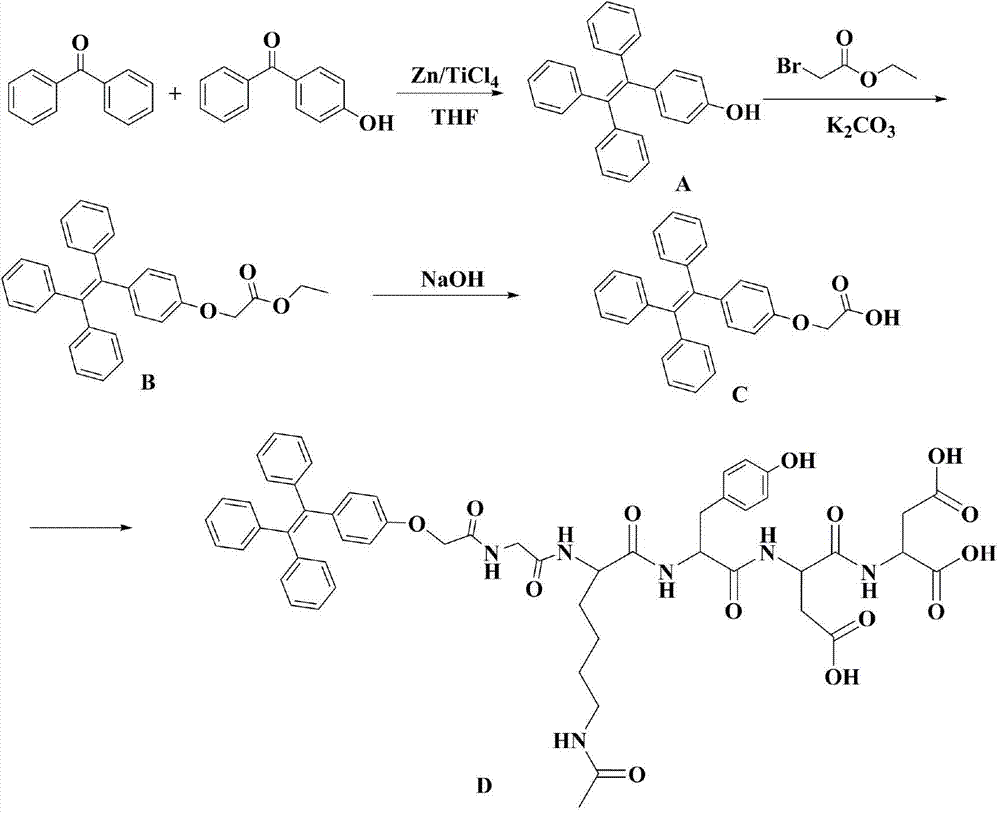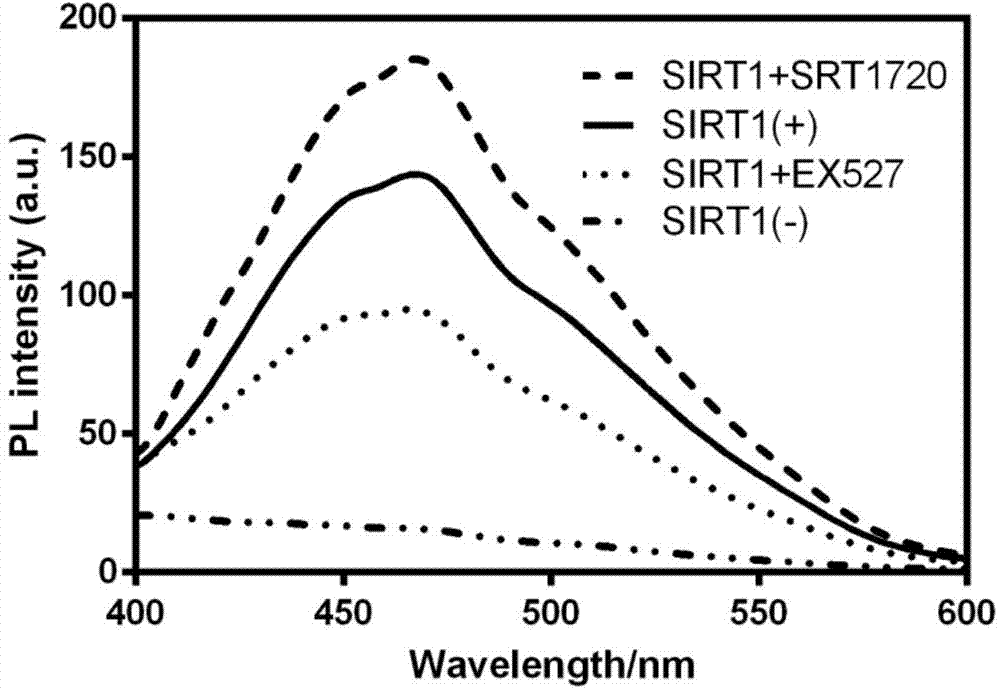Fluorescent probe with aggregation-induced luminescent property and preparation method and application of fluorescent probe
A technology of aggregation-induced luminescence and fluorescent probes, which is applied in the field of drug screening and evaluation, can solve the problem of not being able to specifically identify SIRT1 protein AIE fluorescent probes, and achieve the effect of enhancing the fluorescence absorption intensity
- Summary
- Abstract
- Description
- Claims
- Application Information
AI Technical Summary
Problems solved by technology
Method used
Image
Examples
Embodiment 1
[0063] Embodiment 1 has the fluorescent probe synthesis of AIE characteristic
[0064] A kind of synthetic method of the fluorescent probe with AIE characteristic of this embodiment, its synthetic procedure is as follows figure 1 shown, including:
[0065] (1) Add 4-hydroxybenzophenone (1.9g, 10mmol), benzophenone (2.2g, 12mmol) and zinc powder (2.9g, 44mmol) into a 250ml three-necked flask, pump air, nitrogen, and repeat three times; Add 80ml of THF (tetrahydrofuran), 0 ℃ ice-water bath for 30min; dropwise add titanium tetrachloride (2.4ml, 22mmol) under ice-water bath, reflux overnight, spin dry; add appropriate amount of dichloromethane and dilute hydrochloric acid for extraction, remove the organic Layer was dried with anhydrous magnesium sulfate, filtered, spin-dried, and subjected to silica gel column chromatography, first washed with petroleum ether: ethyl acetate = 20:1 solvent, and then washed with petroleum ether: ethyl acetate = 8:1 solvent, The part washed down a...
Embodiment 2
[0071] Example 2 Application of Fluorescent Probe TPE-GK(Ac)YDD in Detection of SIRT1 Protein Activity
[0072] (1) Detection of SIRT1 protein activity by fluorescent probe TPE-GK(Ac)YDD
[0073] Sample group 1: add 50μL SIRT1 (0.72mg / mL), 12μL TPE-GK(Ac)YDD (1mM), 30μL lysyl endopeptidase (14μg / mL) and 36μL NAD + (50mM);
[0074] Sample group 2: add 50 μL SIRT1 (0.72mg / mL), 12 μL TPE-GK(Ac)YDD (1mM), 30 μL lysyl endopeptidase (14 μg / mL), agonist SRT1720 (500nM) and 36 μL NAD + (50mM);
[0075] Sample group 3: add 50μL SIRT1 (0.72mg / mL), 12μL TPE-GK(Ac)YDD (1mM), 30μL lysyl endopeptidase (14μg / mL), inhibitor EX527 (200nM) and 36μL NAD + (50mM);
[0076] Sample group 4: Add 12 μL TPE-GK(Ac)YDD (1 mM), 30 μL lysyl endopeptidase (14 μg / mL) and 36 μL NAD + (50mM);
[0077] All four sample groups were incubated at 37°C for 3 hours. After the reaction, a JASCO FP-6500 spectrophotometer was used to measure the fluorescence spectrum from 400 nm to 600 nm under 320 nm excitation...
Embodiment 3
[0097] Example 3 Application of Fluorescent Probe TPE-GK(Ac)YDD in Screening SIRT1 Regulators
[0098] (1) Application of fluorescent probe TPE-GK(Ac)YDD in screening SIRT1 inhibitors
[0099] Take 2 μL fluorescent probe TPE-GK(Ac)YDD (1mM), add 10 μL SIRT1 (0.288mg / ml), 10 μL lysyl endopeptidase (14 μg / mL), 6 μL NAD + (50mM), 10μL of different concentrations of EX527 stock solution (making the final concentration of EX527 0, 10, 25, 50, 100, 200, 500, 750, 1000, 2000nM), make up to 100μL with Tris-Hcl buffer solution pH 8.8, incubate at 37°C for 3h, and use Tecan enzyme labeling instrument measurement, set E x 320nm (25nm), E m is 465 (25nm).
[0100] See the test results Figure 8 .
[0101] Depend on Figure 8 It can be seen that with the increase of the final concentration of EX527, the inhibitory effect of EX527 on SIRT1 protein also gradually increases; indicating that the fluorescent probe TPE-GK(Ac)YDD can better reflect the inhibition of SIRT1 protein and can be...
PUM
 Login to View More
Login to View More Abstract
Description
Claims
Application Information
 Login to View More
Login to View More - R&D
- Intellectual Property
- Life Sciences
- Materials
- Tech Scout
- Unparalleled Data Quality
- Higher Quality Content
- 60% Fewer Hallucinations
Browse by: Latest US Patents, China's latest patents, Technical Efficacy Thesaurus, Application Domain, Technology Topic, Popular Technical Reports.
© 2025 PatSnap. All rights reserved.Legal|Privacy policy|Modern Slavery Act Transparency Statement|Sitemap|About US| Contact US: help@patsnap.com



